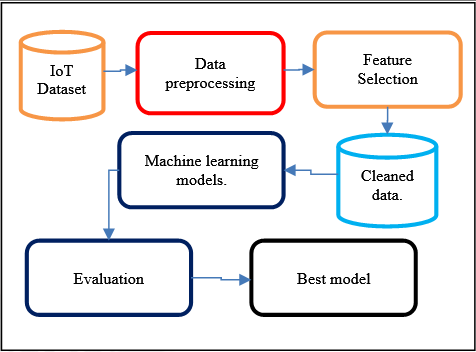Empirical Research on Machine Learning Models and Feature Selection for Traffic Congestion Prediction in Smart Cities
Main Article Content
Abstract
The development of smart cities has occurred over the past ten years. One primary goal of “smart city” initiatives is to lessen vehicle congestion. Several innovative technologies, including vehicular communications, navigation, and traffic control, have been created by Vehicle Networking System to address this problem. The traffic data gathered by smart devices aids in the forecasting of traffic in smart cities. This project created an Intelligent Traffic Congestion Management System (ITCMS) that uses machine learning techniques and traffic data from Kaggle to decrease the amount of time spent stuck in traffic. This study aims to assess feature selection methods and machine learning models for traffic forecasting in smart cities. The feature dimension is reduced using feature selection techniques, such information gain, correlation attribute, and principal component analysis. The recommended model successfully predicted traffic flow, assisting in the alleviation of congestion. The principal component analysis with random forest model outperforms the other machine learning models and has a 95% accuracy rate.
Article Details
References
Lidia Fotia, Flávia Delicato, and Giancarlo Fortino. “Trust in Edge-based Internet of Things Architectures: State of the Art and Research Challenges”. ACM Comput. Surv. Vol. 55, No. 9, September 2023. Available from: https://doi.org/10.1145/3558779.
S. Alexander Suresh SDB and Dr.Jemima Priyadarsini, ETSET: “Enhanced Tiny Symmetric Encryption Techniques to Secure Data Transmission among IoT Devices”, Turkish Journal of Computer and Mathematics Education, vol.12 No.10: pp. 1094-1099, 2021. Available from: https://doi.org/10.17762/turcomat.v12i10.4294
C. Linda Hepsiba, Dr. R. Jemima Priyadarsini, Dr. S. Titus, “A Comprehensive Study on Routing Attacks with Countermeasures in Internet of Things”, Solid State Technology, vol. 63 No. 4, pp. 7993-7999, 2020. Available from: http://solidstatetechnology.us/index.php/JSST/article/view/8339
Jeethu Mathew, Dr. R. Jemima Priyadarsini, “A Review on DoS Attacks in IoT”, Solid State Technology, Vol. 63 No. 4, pp. 8000-8009, 2020. Available from: http://solidstatetechnology.us/index.php/JSST/article/view/8340
Mr. S. Alexander Suresh, Dr. R. Jemima Priyadarsini, “A Comprehensive Study on Sybil Attacks and Its Defence Mechanisms in Internet of Things”, Solid State Technology, Vol. 63 No. 4, pp. 7966 – 7974, 2020. Available from: http://solidstatetechnology.us/index.php/JSST/article/view/8337
Gupta, S, Singh, N. “Toward intelligent resource management in dynamic Fog Computing-based Internet of Things environment with Deep Reinforcement Learning: A survey”. Int J Commun Syst. Vol. 36, no. 4, 2023. Available from: doi:10.1002/dac.5411
Firdose Saeik, Marios Avgeris, Dimitrios Spatharakis, Nina Santi, Dimitrios Dechouniotis, John Violos, Aris Leivadeas, Nikolaos Athanasopoulos, Nathalie Mitton, Symeon Papavassiliou, “Task offloading in Edge and Cloud Computing: A survey on mathematical, artificial intelligence and control theory solutions”, Computer Networks, vol. 195, 2021. Available from: https://doi.org/10.1016/j.comnet.2021.108177.
W. Kong, X. Li, L. Hou, J. Yuan, Y. Gao and S. Yu, “A Reliable and Efficient Task Offloading Strategy Based on Multifeedback Trust Mechanism for IoT Edge Computing,” proc in IEEE Internet of Things Journal, vol. 9, no. 15, pp. 13927-13941, Aug.1, 2022. Available from: doi: 10.1109/JIOT.2022.3143572.
Dechouniotis, D.; Athanasopoulos, N.; Leivadeas, A.; Mitton, N.; Jungers, R.; Papavassiliou, S. “Edge Computing Resource Allocation for Dynamic Networks: The DRUID-NET Vision and Perspective”, Sensors 2020, vol. 20, 2191. https://doi.org/10.3390/s20082191
Kumar, Vijay and Gunner, Sam and Spyridopoulos, Theodoros and Vafeas, Antonis and Pope, James and Yadav, Poonam and Oikonomou, George and Tryfonas, Theo. “Challenges in the Design and Implementation of IoT Testbeds in Smart-Cities: A Systematic Review”. arXiv, 2023. Available from: https://doi.org/10.48550/arxiv.2302.11009
Casmir Onyeneke, Chibuzor Eguzouwa, Charles Mutabazi, Modeling the Effects of Traffic Congestion on Economic Activities - Accidents, Fatalities and Casualties, Biomedical Statistics and Informatics, Vol. 3, pp. 7-14, 2018. Available from: https://doi.org/10.11648/j.bsi.20180302.11
Preeti Rani, Rohit Sharma. “Intelligent transportation system for internet of vehicles based vehicular networks for smart cities”. Computers and Electrical Engineering, Vol. 105, January 2023. Available from: https://doi.org/10.1016/j.compeleceng.2022.108543
Bawaneh, M, Simon, V. Novel traffic congestion detection algorithms for smart city applications. Concurrency Computat Pract Exper. 2023; 35( 5):e7563. doi:10.1002/cpe.7563
F. Rempe, G. Huber, and K. Bogenberger, “Spatio-temporal congestion patterns in urban traffic networks”, Transportation Research Procedia, vol. 15, pp. 513–524, 2016. Available from: https://doi.org/10.1016/j.trpro.2016.06.043
C. Song, H. Lee, C. Kang, W. Lee, Y. B. Kim and S. W. Cha, Traffic speed prediction under weekday using convolutional neural networks concepts, Proc. in 2017 IEEE Intelligent Vehicles Symposium (IV), 2017: pp. 1293-1298. Available from: https://doi.org/10.1109/IVS.2017.7995890.
Shengdong Du, Tianrui Li, Xun Gong, Shi-Jinn Horng, A hybrid method for traffic flow forecasting using multimodal deep learning. International journal of computational intelligence systems, vol. 13, pp. 85–97, 2020. Available from: https://doi.org/10.48550/arXiv.1803.02099
A. Moses and R. Parvathi, "Vehicular Traffic analysis and prediction using Machine learning algorithms," Proc. in International Conference on Emerging Trends in Information Technology and Engineering (ic-ETITE), 2020: pp. 1-4. Available from: https://doi.org/10.1109/ic-ETITE47903.2020.279.
J.-H. Bang and J.-R. Lee, Collision avoidance method using vector-based mobility model in TDMA-based vehicular ad hoc networks, Applied Sciences, vol. 10, 2020. Available from: https://doi.org/10.3390/app10124181
Wangyang Wei, Honghai Wu and Huadong Ma. An auto encoder and LSTM based traffic flow prediction method, Sensors, vol. 19, no. 13, 2019. Available from: https://doi.org/10.3390/s19132946.
Muhammad Saleem, Sagheer Abbas, Taher M. Ghazal, Muhammad Adnan Khan, Nizar Sahawneh, Munir Ahmad, Smart cities: Fusion-based intelligent traffic congestion control system for vehicular networks using machine learning techniques, Egyptian Informatics Journal, vol 23, no. 3, pp. 417-426, 2022. Available from: https://doi.org/10.1016/j.eij.2022.03.003
Smart city traffic dataset. [Online]. Available: https://www.kaggle.com/vetrirah/ml-iot accessed on 20-November-2022.

